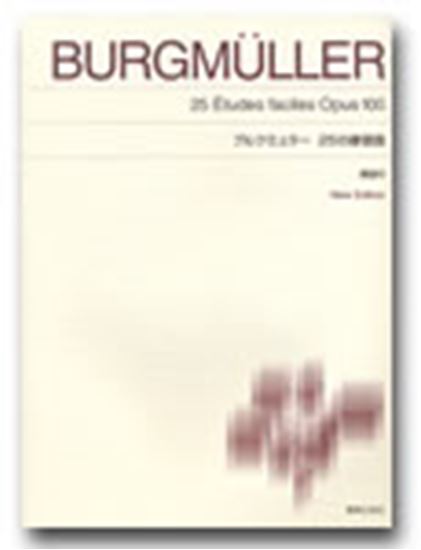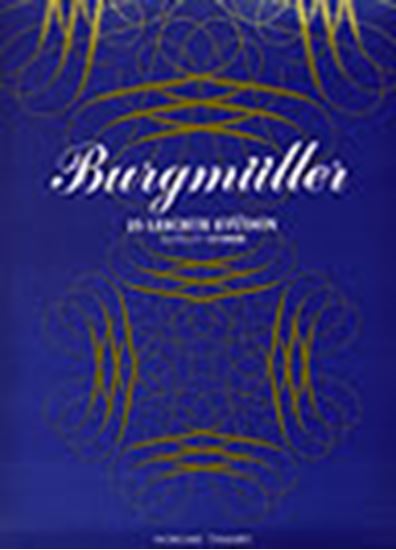Burgmüller, Johann Friedrich Franz : 25 Etudes faciles et progressives, conposées et doigtées expressément pour l'étendue des petites mains Le courant limpide Op.100-7
Work Overview
Genre:etude
Total Playing Time:1 min 00 sec
Copyright:Public Domain
Additional Notes:表記ゆれの例: 清いながれ 清い流れ きよい流れ 小川 清らかな小川
Commentary (3)
Author : Sato, Takashi
Last Updated: January 31, 2022
[Open]
Author : Sato, Takashi
The murmuring of a quiet brook is depicted by triplet arpeggios. Since it resembles the accompaniment pattern of the second song, 'Wohin?' from Schubert's song cycle 'Die schöne Müllerin,' it would be beneficial to refer to its musical character as well.
The term mormorendo at the beginning means 'murmuring' or 'whispering.' The evolution of the piano, specifically the introduction of hammerheads made from softer materials, enabled such subtle expressions.
Performance Points (Original Tempo ♩=176)
Pay attention to the changes in volume and timbre between the main melody, played by the first finger with quarter note stems, and the other triplets. Especially when ascending in measure 2, ensure that the first note of repeated notes does not receive an accent. The top note of each beat also accompanies the main melody like a shadow. From measure 9, these two voices separate into the left and right hands; enjoy playing them as they intertwine independently.
(From To-on Edition "Burgmüller 25 Études" (NS70))
Author : Iida, Arisa
Last Updated: March 15, 2018
[Open]
Author : Iida, Arisa
Musical example provided by: Ongaku no Tomo Sha
Author : Ooi, Kazurou
Last Updated: January 31, 2019
[Open]
Author : Ooi, Kazurou
General Approach
The essence of this piece lies precisely in how smoothly it can flow horizontally. The left hand features four quarter notes in almost every measure, thereby marking the beat. This tends to lead to a vertically-oriented musical texture, making the primary challenge how to execute this left hand at pp. A fingering of approximately 5-2-5-2 should generally be suitable (excluding the middle section).
Left Hand Technique at pp
Regarding the left-hand sound, there are two crucial points to consider when playing at pp:
- Firstly, the sound must possess a core. Regardless of how pp it is, the sound must not be lifeless, fading, or fragile. We aim for a pp with substance, and to achieve this, it is first necessary to practice the left hand at FF.
- Secondly, the sound must not disappear or become indistinct. Practicing at FF will also prevent the sound from becoming indistinct.
Right Hand Melody (Measures 1-8)
Building upon this, in the first eight measures, there are notes in the right hand with two stems. These notes constitute the melodic line. While some may find this not particularly melodic, if one were to extract and connect only the second note of the right-hand triplet, it too forms an unmelodic voice. The third note of the triplet is out of the question. Consequently, the first note of the triplet indeed emerges as the melodic line. It is imperative that these melodic lines are clearly articulated, while the remaining notes are played as pp as possible.
Rubato
Furthermore, apply rubato. A light application of rubato will eliminate any rigidity.
Measures 9-16
For measures 9-16, it is reasonable to consider the left hand as forming the melodic line. However, the truly melodic element is the second note of the right-hand triplet. While the left hand is brought out, the second note of the right-hand triplet might be perceived as flowing from the background and harmonizing.
For instance, as one possible interpretative approach, one might emphasize the left hand for measures 9-12, and the second note of the right-hand triplet for measures 13-16.
Arrangements & Related Works(5)
Yoshida, Ena: Le courant limpide
Total Performance Time: 1 min 40 sec
Hashimoto Reiko: Le courant limpide
Total Performance Time: 1 min 30 sec
PTNA & Partner Channel Videos(18items) View More
Sheet MusicView More
Scores List (25)

(株)東音企画(バスティン)

(株)東音企画(バスティン)

(株)東音企画(バスティン)

(株)全音楽譜出版社

(株)ドレミ楽譜出版社

(株)音楽之友社

KMP(ケイ・エム・ピー) ケイエムピー

(株)ドレミ楽譜出版社

ハンナ(ショパン)

(株)ヤマハミュージックエンタテインメントホールディングス

デプロMP

(株)ドレミ楽譜出版社

(株)全音楽譜出版社

(株)ドレミ楽譜出版社

カワイ出版

カワイ出版

デプロMP

(株)ヤマハミュージックエンタテインメントホールディングス

デプロMP

(株)ドレミ楽譜出版社

(株)音楽之友社

(株)共同音楽出版社

Neil A. Kjos Music Company



















